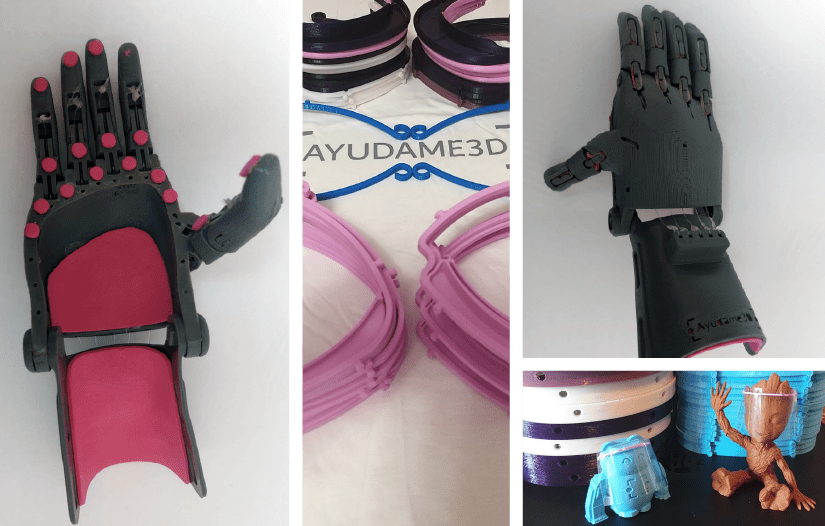Is 3D printing just a hobby?

R2-D2, WALL·E, C-3PO, Johnny 5, Bender... they all have something in common, and I’m sure you’ve already guessed it. They’re robots! I honestly don’t know why, but I’ve been fascinated by these machines for as long as I can remember. It is often said that our childhood shapes what we will be in the future or at least sets us up for it, and given my love for robotics, my family and friends had no doubt that I would end up studying something related to this field and working in a company like GMV, where I could pursue my technological interests. GMV would be the perfect company for me given its investments in robotic exploration, its projects involving missions to the moon and Mars, and its endeavors with autonomous systems. Without getting ahead of myself, I’ll tell you that GMV also has 3D printers so that it can use additive technology to furnish prototypes. But I will talk about 3D printers later on.
It was in the first year of my bachelor’s degree that I had what you might call technological love at first sight. While wandering the halls of the university and scurrying from lab to lab, I came across some machines that seemed to spit out plastic and build objects as a result. I didn’t know it at the time, but that would be my first contact with a 3D printer and additive technology. The truth is that I didn’t really know what 3D printers were, nor what it would cost to make one, much less anything about the underlying additive technology. But what I did know for sure was that I would eventually have one of my own.
I reached out to the people who ran the 3D printers and they helped me build what was to be my first 3D printer. Since then I’ve had more than three! At the time, getting one was difficult and expensive, as many of the materials had to be ordered from outside the country. For those of you who are unfamiliar with 3D printers, the way they work is quite straightforward: A coiled plastic filament passes through an extruder, which melts it and deposits it in successive layers until the real-life model is formed. This requires following a pattern, which is created using a program that divides the object to be printed into layers.
I was amazed by 3D printing. I could imagine whatever I wanted and simply print it out; all it took was a 3D computer-aided design model. It was effortless and I didn’t even have to design the objects because there were already so many that had been made by other people in the community and uploaded to online platforms. At the beginning, as you might expect, I could only come up with things as useful as a coat rack or an action figure. However, I kept racking my brain thinking about how I could get more use and value out of my 3D printer.
It was not until much later and after owning other 3D printers that the answer appeared before me. I was looking through social media when I came across Ayúdame3D, a project through which 3D-printed prosthetic arms, called trésdesis (a play on the Spanish words for “three” and “prosthesis”), are created and delivered free of charge to people with disabilities. The trésdesis allow some prehensile movement thanks to whatever joint the person still has, whether the wrist, elbow, or shoulder. The organization collects data on the people who need a prosthesis, determines the trésdesis they need, and contacts one of the people from the association, who they call Helpers3D, to print, assemble, package, and deliver the prosthesis to its end user.
It is very exciting to see how a 3D printer and a few hours of printing and assembly can bring a smile to someone without resources who cannot afford a prosthesis. Many of the people the trésdesis go to live in third world countries.
Ayúdame3D began by making trésdesis for people in need, but nowadays it has expanded its help by providing masks to health workers during the pandemic (where GMV also contributed by lending us some materials to make them) and by collaborating with hospitals to create chemboxes. Chemboxes are designed to hold the chemotherapy bags used for treating children. They are decorated with children’s characters (from Star Wars, Frozen, Spider-Man, etc.) as a way to make the treatment and hospital stay more child-friendly.
Ayúdame3D has grown non-stop over the years and has launched a new platform this year to better organize the Helpers3D team and streamline the workflow so that help can reach as many people as possible.
It is a pride and a pleasure to be able to make this world a better place using a tool such as the 3D printer, which was originally meant to be a hobby. Thanks to associations like Ayúdame3D, companies like GMV, and the collaboration of hundreds of people with technological and human concerns, we will be able to improve the world. I hope to continue for many more years running my 3D printers, embarking on new adventures, and doing my bit to make some people’s lives a little happier. The only question left is... What will the next 3D adventure be?
Author: Rafael Leor